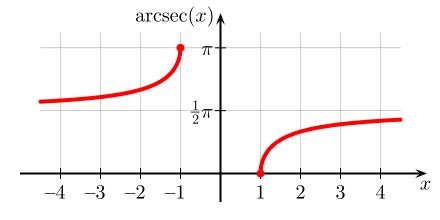Arkussekans und Arkuskosekans sind zyklometrische Funktionen. Sie sind die Umkehrfunktionen der Sekansfunktion bzw. der Kosekansfunktion und damit Arkusfunktionen . Da die Sekans- und die Kosekansfunktion periodisch sind, wird zur Umkehrung der Definitionsbereich von Sekans auf
[
0
,
π
]
{\displaystyle \lbrack 0\,,\,\pi \rbrack }
[
−
π
/
2
,
π
/
2
]
{\displaystyle \lbrack -{\pi /2},\,\pi /2\rbrack }
arcsec
(
x
)
{\displaystyle \operatorname {arcsec} \,(x)}
arccsc
(
x
)
{\displaystyle \operatorname {arccsc} \,(x)}
sec
−
1
(
x
)
{\displaystyle \sec ^{-1}(x)}
csc
−
1
{\displaystyle \csc ^{-1}}
arcsec
{\displaystyle \operatorname {arcsec} }
arccsc
{\displaystyle \operatorname {arccsc} }
Kehrwerte von
sec
{\displaystyle \sec }
csc
{\displaystyle \csc }
Arkussekans
Arkuskosekans
Funktions-
Definitionsbereich
−
∞
<
x
≤
−
1
,
1
≤
x
<
+
∞
{\displaystyle -\infty <x\leq -1\,,\,1\leq x<+\infty }
−
∞
<
x
≤
−
1
,
1
≤
x
<
+
∞
{\displaystyle -\infty <x\leq -1\,,\,1\leq x<+\infty }
Wertebereich
0
≤
f
(
x
)
≤
π
{\displaystyle 0\leq f(x)\leq \pi }
−
π
2
≤
f
(
x
)
≤
π
2
{\displaystyle -{\frac {\pi }{2}}\leq f(x)\leq {\frac {\pi }{2}}}
Monotonie
In beiden Abschnitten jeweils streng monoton steigend
In beiden Abschnitten jeweils streng monoton fallend
Symmetrien
Punktsymmetrie zum Punkt
x
=
0
,
y
=
π
2
{\displaystyle x=0,y={\frac {\pi }{2}}}
Ungerade Funktion
arccsc
(
x
)
=
−
arccsc
(
−
x
)
{\displaystyle \operatorname {arccsc} \,(x)=-\operatorname {arccsc} \,(-x)}
Asymptoten
f
(
x
)
→
π
2
{\displaystyle f(x)\to {\frac {\pi }{2}}}
x
→
±
∞
{\displaystyle x\to \pm \infty }
f
(
x
)
→
0
{\displaystyle f(x)\to 0}
x
→
±
∞
{\displaystyle x\to \pm \infty }
Nullstellen
x
=
1
{\displaystyle x=1\!\,}
keine
Sprungstellen
keine
keine
Polstellen
keine
keine
Extrema
Minimum bei
(
1
|
0
)
{\displaystyle \left(1|0\right)}
(
−
1
|
π
)
{\displaystyle \left(-1|\pi \right)}
Minimum bei
(
−
1
|
−
π
2
)
{\displaystyle \left(-1|-{\frac {\pi }{2}}\right)}
(
1
|
π
2
)
{\displaystyle \left(1|{\frac {\pi }{2}}\right)}
Wendepunkte
keine
keine
Die Reihenentwicklungen von Arkussekans und Arkuskosekans sind:
arcsec
(
x
)
=
π
2
−
∑
k
=
0
∞
(
2
k
−
1
)
!
!
x
−
(
2
k
+
1
)
(
2
k
)
!
!
⋅
(
2
k
+
1
)
≈
π
2
−
x
−
1
−
1
6
x
−
3
−
3
40
x
−
5
{\displaystyle \operatorname {arcsec}(x)={\frac {\pi }{2}}-\sum _{k=0}^{\infty }{\frac {(2k-1)!!x^{-(2k+1)}}{(2k)!!\cdot (2k+1)}}\approx {\frac {\pi }{2}}-x^{-1}-{\frac {1}{6}}x^{-3}-{\frac {3}{40}}x^{-5}}
arccsc
(
x
)
=
∑
k
=
0
∞
(
2
k
−
1
)
!
!
x
−
(
2
k
+
1
)
(
2
k
)
!
!
⋅
(
2
k
+
1
)
=
1
x
+
1
2
⋅
3
x
3
+
3
2
⋅
4
⋅
5
x
5
+
3
⋅
5
2
⋅
4
⋅
6
⋅
7
x
7
+
…
{\displaystyle \operatorname {arccsc}(x)=\sum _{k=0}^{\infty }{\frac {(2k-1)!!x^{-(2k+1)}}{(2k)!!\cdot (2k+1)}}={\frac {1}{x}}\;+\;{\frac {1}{2\cdot 3x^{3}}}\;+\;{\frac {3}{2\!\cdot \!4\cdot 5x^{5}}}\;+\;{\frac {3\!\cdot \!5}{2\!\cdot \!4\!\cdot \!6\cdot 7x^{7}}}\;+\;\ldots }
Für den Arkussekans und Arkuskosekans existieren folgende Integraldarstellungen:
arcsec
(
x
)
=
∫
1
x
d
t
t
t
2
−
1
{\displaystyle \operatorname {arcsec}(x)=\int \limits _{1}^{x}{\frac {\mathrm {d} t}{t{\sqrt {t^{2}-1}}}}}
arccsc
(
x
)
=
∫
x
∞
d
t
t
t
2
−
1
{\displaystyle \operatorname {arccsc}(x)=\int \limits _{x}^{\infty }{\frac {\mathrm {d} t}{t{\sqrt {t^{2}-1}}}}}
Die Ableitungen sind gegeben durch:
d
d
x
arcsec
(
x
)
=
1
|
x
|
x
2
−
1
{\displaystyle {\frac {\mathrm {d} }{\mathrm {d} x}}\operatorname {arcsec} (x)={\frac {1}{|x|{\sqrt {x^{2}-1}}}}}
d
d
x
arccsc
(
x
)
=
−
1
|
x
|
x
2
−
1
{\displaystyle {\frac {\mathrm {d} }{\mathrm {d} x}}\operatorname {arccsc} (x)=-{\frac {1}{|x|{\sqrt {x^{2}-1}}}}}
∫
arcsec
(
x
)
d
x
=
x
⋅
arcsec
(
x
)
−
sgn
(
x
)
⋅
ln
(
|
x
+
x
2
−
1
|
)
+
C
=
x
⋅
arcsec
(
x
)
−
arcosh
(
|
x
|
)
+
C
{\displaystyle \int \operatorname {arcsec} (x)\,\mathrm {d} x=x\cdot \operatorname {arcsec} (x)-\operatorname {sgn}(x)\cdot \ln \left(\left|x+{\sqrt {x^{2}-1}}\right|\right)+C=x\cdot \operatorname {arcsec} (x)-\operatorname {arcosh} (|x|)+C}
∫
arccsc
(
x
)
d
x
=
x
⋅
arccsc
(
x
)
+
sgn
(
x
)
⋅
ln
(
|
x
+
x
2
−
1
|
)
+
C
=
x
⋅
arccsc
(
x
)
+
arcosh
(
|
x
|
)
+
C
{\displaystyle \int \operatorname {arccsc} (x)\,\mathrm {d} x=x\cdot \operatorname {arccsc} (x)+\operatorname {sgn}(x)\cdot \ln \left(\left|x+{\sqrt {x^{2}-1}}\right|\right)+C=x\cdot \operatorname {arccsc} (x)+\operatorname {arcosh} (|x|)+C}
arcsec
(
x
)
=
arccos
(
1
x
)
{\displaystyle \operatorname {arcsec} \,(x)=\arccos \left({\frac {1}{x}}\right)}
arccsc
(
x
)
=
arcsin
(
1
x
)
{\displaystyle \operatorname {arccsc} \,(x)=\arcsin \left({\frac {1}{x}}\right)}


































